Organisational Behaviour Report: Analyzing M&S's Workplace Dynamics
VerifiedAdded on 2020/11/30
|22
|6777
|70
Report
AI Summary
This report provides a comprehensive analysis of organizational behaviour, focusing on the influence of culture, politics, and power within the context of Marks and Spencer. It examines how these factors impact individual and team performance, and explores various motivational theories and techniques to achieve organizational goals. The report also evaluates strategies for effective teamwork and cooperation, drawing on relevant team development theories. Furthermore, it applies organizational behaviour concepts and philosophies to a given business situation, assessing their positive and negative influences on workplace behaviour. The analysis includes a critical assessment of team development theories and organizational behaviour concepts that affect workplace behaviour, offering insights into how Marks and Spencer can improve its organizational dynamics. The report covers various aspects of organizational behaviour, including culture, politics, power, motivation, team dynamics, and their practical implications within a business context.
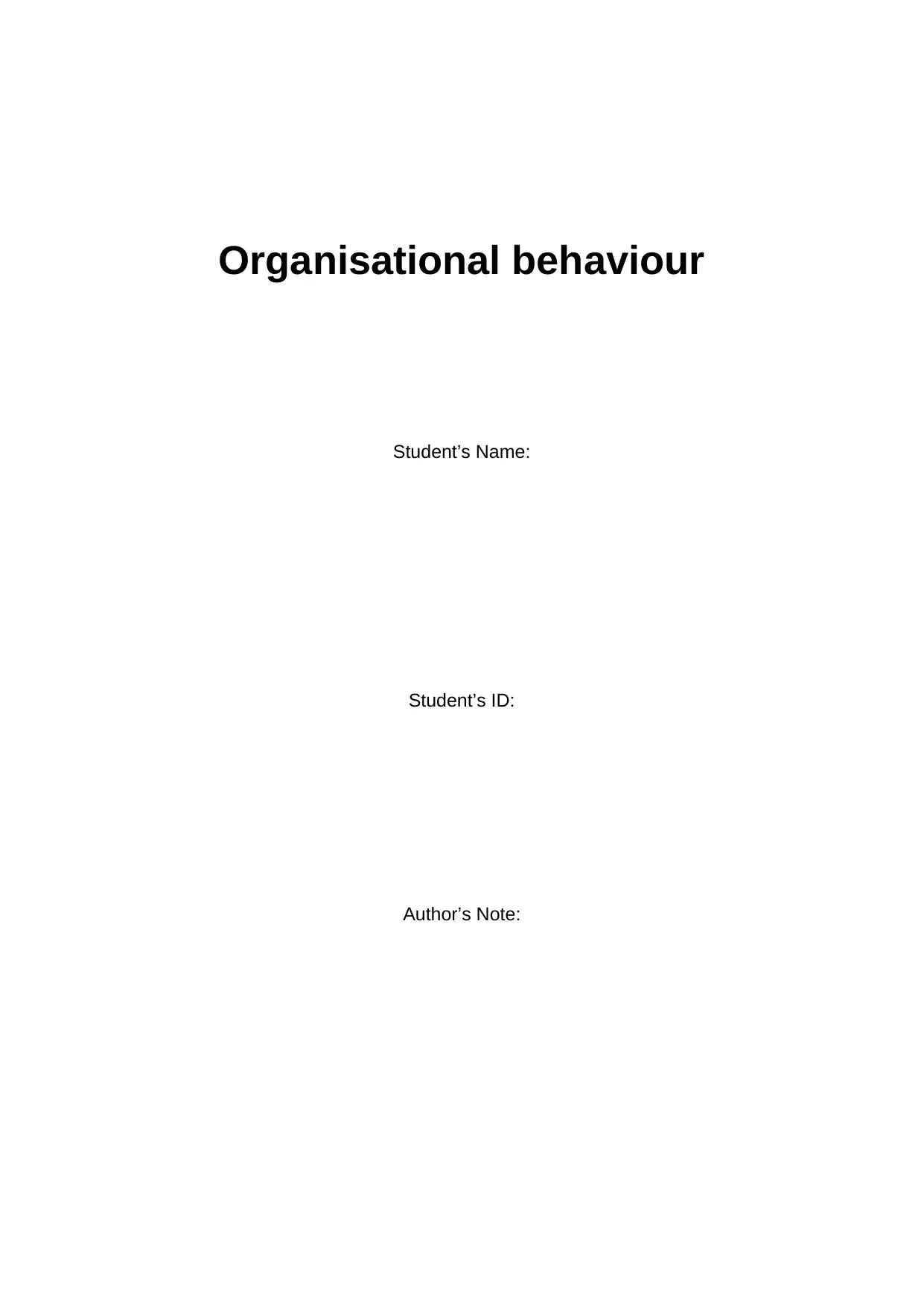
Organisational behaviour
Student’s Name:
Student’s ID:
Author’s Note:
Student’s Name:
Student’s ID:
Author’s Note:
Paraphrase This Document
Need a fresh take? Get an instant paraphrase of this document with our AI Paraphraser

Table of Contents
Introduction................................................................................................................. 3
1. Analyse the influence of culture, politics and power on the behaviour of others in
an organisational context............................................................................................4
1.1 Understanding how politics, culture and power can influence the organisational
team and individual performance and behaviour.....................................................4
1.2 Scrutinising critically that how corporate power, culture and politics can
influence the behaviour and competence of people and team................................5
1.3 Appraise analytically the link among motivation, politics, power and culture that
enables organisations and teams to subsists on the suggestion.............................6
2. Evaluate how to motivate individuals and teams to achieve a goal.........................7
2.1 Evaluation of how the motive and content motivational theories together with
motivational techniques can help in attaining the organisational goals...................7
2.2 Critical evaluation of the process of influencing the behaviours of others
through the application of behavioural theories, concepts and models.................10
3. Demonstrate an understanding of how to co-operate effectively with others........12
3.1 Demonstration about what allows a group to be expensive in comparison with
an ineffective team................................................................................................ 12
3.2 Examination of relevant team development theories to assist the development
of dynamic co-operation of team within the workplace..........................................13
4. Apply concepts and philosophies of organisational behaviour to a given business
situation.....................................................................................................................15
4.1 Application of OB framework on the contemporary scenario of the organisation
...............................................................................................................................15
4.2 Justification and evaluation of various concepts and philosophies and
assessing how they influence behaviour both positively and negatively...............17
4.3 Critical assessment and evaluation of team development theories and OB
concepts and philosophies that can affect the workplace behaviour.....................19
Conclusion................................................................................................................ 20
References................................................................................................................21
Page | 2
Introduction................................................................................................................. 3
1. Analyse the influence of culture, politics and power on the behaviour of others in
an organisational context............................................................................................4
1.1 Understanding how politics, culture and power can influence the organisational
team and individual performance and behaviour.....................................................4
1.2 Scrutinising critically that how corporate power, culture and politics can
influence the behaviour and competence of people and team................................5
1.3 Appraise analytically the link among motivation, politics, power and culture that
enables organisations and teams to subsists on the suggestion.............................6
2. Evaluate how to motivate individuals and teams to achieve a goal.........................7
2.1 Evaluation of how the motive and content motivational theories together with
motivational techniques can help in attaining the organisational goals...................7
2.2 Critical evaluation of the process of influencing the behaviours of others
through the application of behavioural theories, concepts and models.................10
3. Demonstrate an understanding of how to co-operate effectively with others........12
3.1 Demonstration about what allows a group to be expensive in comparison with
an ineffective team................................................................................................ 12
3.2 Examination of relevant team development theories to assist the development
of dynamic co-operation of team within the workplace..........................................13
4. Apply concepts and philosophies of organisational behaviour to a given business
situation.....................................................................................................................15
4.1 Application of OB framework on the contemporary scenario of the organisation
...............................................................................................................................15
4.2 Justification and evaluation of various concepts and philosophies and
assessing how they influence behaviour both positively and negatively...............17
4.3 Critical assessment and evaluation of team development theories and OB
concepts and philosophies that can affect the workplace behaviour.....................19
Conclusion................................................................................................................ 20
References................................................................................................................21
Page | 2

Introduction
Organisational behaviour is referred to an approach, on the basis of which both the
bustle and the recital of an individual indoors an organisation is restrained. The
context of the analysis itself obtains the significance within a business entity through
which behaviour of an individual in terms of workers can be examined within the
place of work. Correspondingly, the study helps to acknowledge the effectiveness of
organisational behaviour upon the job profile, work presentation, performance along
with the leadership (Hull Live, 2019). The contextual study of organisational
behaviour is associated with politics and power, which has always been acted as a
dominant influential factor over every organisation all over the world.
In this regard, the proper use of power is essential for the organisation to maintain its
sustainability as it helps to regulate the workplace and make proper use of the
working proficiencies of the staffs. Therefore, power ensures the proficiency,
regulation and integrity of the organisation. Instantaneously, organisational culture is
referred to a noteworthy facet that maintains ethics, principles and conventions that
governs the behaviour of an organisation (Tutor2u, 2019). Considering the context, a
comprehensive analysis regarding the scenario of Marks and Spencer which is a
renowned retail organisation in UK is carried out in the following study.
Figure: 1. Store of Marks and Spencer in United Kingdom
(Source: Hull Live, 2019)
Page | 3
Organisational behaviour is referred to an approach, on the basis of which both the
bustle and the recital of an individual indoors an organisation is restrained. The
context of the analysis itself obtains the significance within a business entity through
which behaviour of an individual in terms of workers can be examined within the
place of work. Correspondingly, the study helps to acknowledge the effectiveness of
organisational behaviour upon the job profile, work presentation, performance along
with the leadership (Hull Live, 2019). The contextual study of organisational
behaviour is associated with politics and power, which has always been acted as a
dominant influential factor over every organisation all over the world.
In this regard, the proper use of power is essential for the organisation to maintain its
sustainability as it helps to regulate the workplace and make proper use of the
working proficiencies of the staffs. Therefore, power ensures the proficiency,
regulation and integrity of the organisation. Instantaneously, organisational culture is
referred to a noteworthy facet that maintains ethics, principles and conventions that
governs the behaviour of an organisation (Tutor2u, 2019). Considering the context, a
comprehensive analysis regarding the scenario of Marks and Spencer which is a
renowned retail organisation in UK is carried out in the following study.
Figure: 1. Store of Marks and Spencer in United Kingdom
(Source: Hull Live, 2019)
Page | 3
⊘ This is a preview!⊘
Do you want full access?
Subscribe today to unlock all pages.

Trusted by 1+ million students worldwide
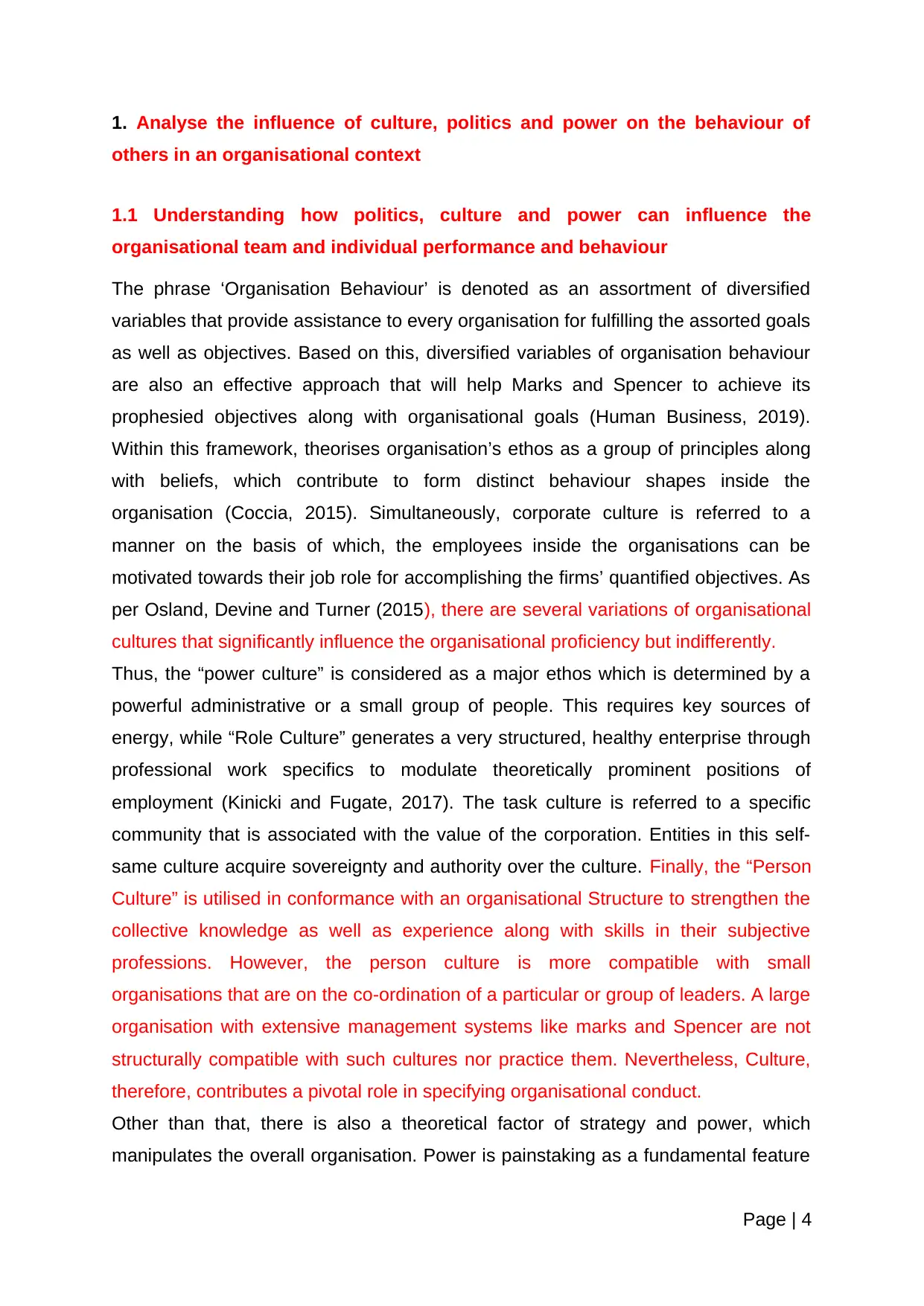
1. Analyse the influence of culture, politics and power on the behaviour of
others in an organisational context
1.1 Understanding how politics, culture and power can influence the
organisational team and individual performance and behaviour
The phrase ‘Organisation Behaviour’ is denoted as an assortment of diversified
variables that provide assistance to every organisation for fulfilling the assorted goals
as well as objectives. Based on this, diversified variables of organisation behaviour
are also an effective approach that will help Marks and Spencer to achieve its
prophesied objectives along with organisational goals (Human Business, 2019).
Within this framework, theorises organisation’s ethos as a group of principles along
with beliefs, which contribute to form distinct behaviour shapes inside the
organisation (Coccia, 2015). Simultaneously, corporate culture is referred to a
manner on the basis of which, the employees inside the organisations can be
motivated towards their job role for accomplishing the firms’ quantified objectives. As
per Osland, Devine and Turner (2015), there are several variations of organisational
cultures that significantly influence the organisational proficiency but indifferently.
Thus, the “power culture” is considered as a major ethos which is determined by a
powerful administrative or a small group of people. This requires key sources of
energy, while “Role Culture” generates a very structured, healthy enterprise through
professional work specifics to modulate theoretically prominent positions of
employment (Kinicki and Fugate, 2017). The task culture is referred to a specific
community that is associated with the value of the corporation. Entities in this self-
same culture acquire sovereignty and authority over the culture. Finally, the “Person
Culture” is utilised in conformance with an organisational Structure to strengthen the
collective knowledge as well as experience along with skills in their subjective
professions. However, the person culture is more compatible with small
organisations that are on the co-ordination of a particular or group of leaders. A large
organisation with extensive management systems like marks and Spencer are not
structurally compatible with such cultures nor practice them. Nevertheless, Culture,
therefore, contributes a pivotal role in specifying organisational conduct.
Other than that, there is also a theoretical factor of strategy and power, which
manipulates the overall organisation. Power is painstaking as a fundamental feature
Page | 4
others in an organisational context
1.1 Understanding how politics, culture and power can influence the
organisational team and individual performance and behaviour
The phrase ‘Organisation Behaviour’ is denoted as an assortment of diversified
variables that provide assistance to every organisation for fulfilling the assorted goals
as well as objectives. Based on this, diversified variables of organisation behaviour
are also an effective approach that will help Marks and Spencer to achieve its
prophesied objectives along with organisational goals (Human Business, 2019).
Within this framework, theorises organisation’s ethos as a group of principles along
with beliefs, which contribute to form distinct behaviour shapes inside the
organisation (Coccia, 2015). Simultaneously, corporate culture is referred to a
manner on the basis of which, the employees inside the organisations can be
motivated towards their job role for accomplishing the firms’ quantified objectives. As
per Osland, Devine and Turner (2015), there are several variations of organisational
cultures that significantly influence the organisational proficiency but indifferently.
Thus, the “power culture” is considered as a major ethos which is determined by a
powerful administrative or a small group of people. This requires key sources of
energy, while “Role Culture” generates a very structured, healthy enterprise through
professional work specifics to modulate theoretically prominent positions of
employment (Kinicki and Fugate, 2017). The task culture is referred to a specific
community that is associated with the value of the corporation. Entities in this self-
same culture acquire sovereignty and authority over the culture. Finally, the “Person
Culture” is utilised in conformance with an organisational Structure to strengthen the
collective knowledge as well as experience along with skills in their subjective
professions. However, the person culture is more compatible with small
organisations that are on the co-ordination of a particular or group of leaders. A large
organisation with extensive management systems like marks and Spencer are not
structurally compatible with such cultures nor practice them. Nevertheless, Culture,
therefore, contributes a pivotal role in specifying organisational conduct.
Other than that, there is also a theoretical factor of strategy and power, which
manipulates the overall organisation. Power is painstaking as a fundamental feature
Page | 4
Paraphrase This Document
Need a fresh take? Get an instant paraphrase of this document with our AI Paraphraser

Different Types of Culture
Power Culture Role Culture Person Culture
that every individual in terms of people of the organisation needs (Natvig and Stark,
2016). An individual may have the accessibility to change the behaviour of the entire
business as well as to deport themselves in the way he or she wishes. In that case,
the goal is to ensure that they never make any changes into their behaviour thus
improving their organisational skill. The power in this aspect assists in managing the
Marks and Spencer’s operation system and in assessing the most significant way to
improve it. Culture, just in the other hand, act as a remarkable factor with
incorporating with the political aspects of the organisation (Alvesson and
Sveningsson, 2015). The purpose of evaluating the power and culture is to ensure
the development of most efficient organisational proficiency by maintaining
regulation and ethical standards within the organisational workplace. By effectively
arranging the organisational culture in resonance with power and politics an
proficient organisational behaviour can be generated that will be beneficial of the
growth of the company and the business.
Figure: 2. Different Types of Organisational Culture
(Source: Chumg et al., 2016)
1.2 Critically assessing how power, culture and politics can influence the
behaviour and competence of people and team
Power and politics play a significant role in deciding the growth, sustainability, as
well as continuing progress within the organisation. In this prospect, the shifts in
employment along with living through diverse societies can be observed due to the
nominal distance between the society and the culture; therefore, culture can also be
Page | 5
Power Culture Role Culture Person Culture
that every individual in terms of people of the organisation needs (Natvig and Stark,
2016). An individual may have the accessibility to change the behaviour of the entire
business as well as to deport themselves in the way he or she wishes. In that case,
the goal is to ensure that they never make any changes into their behaviour thus
improving their organisational skill. The power in this aspect assists in managing the
Marks and Spencer’s operation system and in assessing the most significant way to
improve it. Culture, just in the other hand, act as a remarkable factor with
incorporating with the political aspects of the organisation (Alvesson and
Sveningsson, 2015). The purpose of evaluating the power and culture is to ensure
the development of most efficient organisational proficiency by maintaining
regulation and ethical standards within the organisational workplace. By effectively
arranging the organisational culture in resonance with power and politics an
proficient organisational behaviour can be generated that will be beneficial of the
growth of the company and the business.
Figure: 2. Different Types of Organisational Culture
(Source: Chumg et al., 2016)
1.2 Critically assessing how power, culture and politics can influence the
behaviour and competence of people and team
Power and politics play a significant role in deciding the growth, sustainability, as
well as continuing progress within the organisation. In this prospect, the shifts in
employment along with living through diverse societies can be observed due to the
nominal distance between the society and the culture; therefore, culture can also be
Page | 5
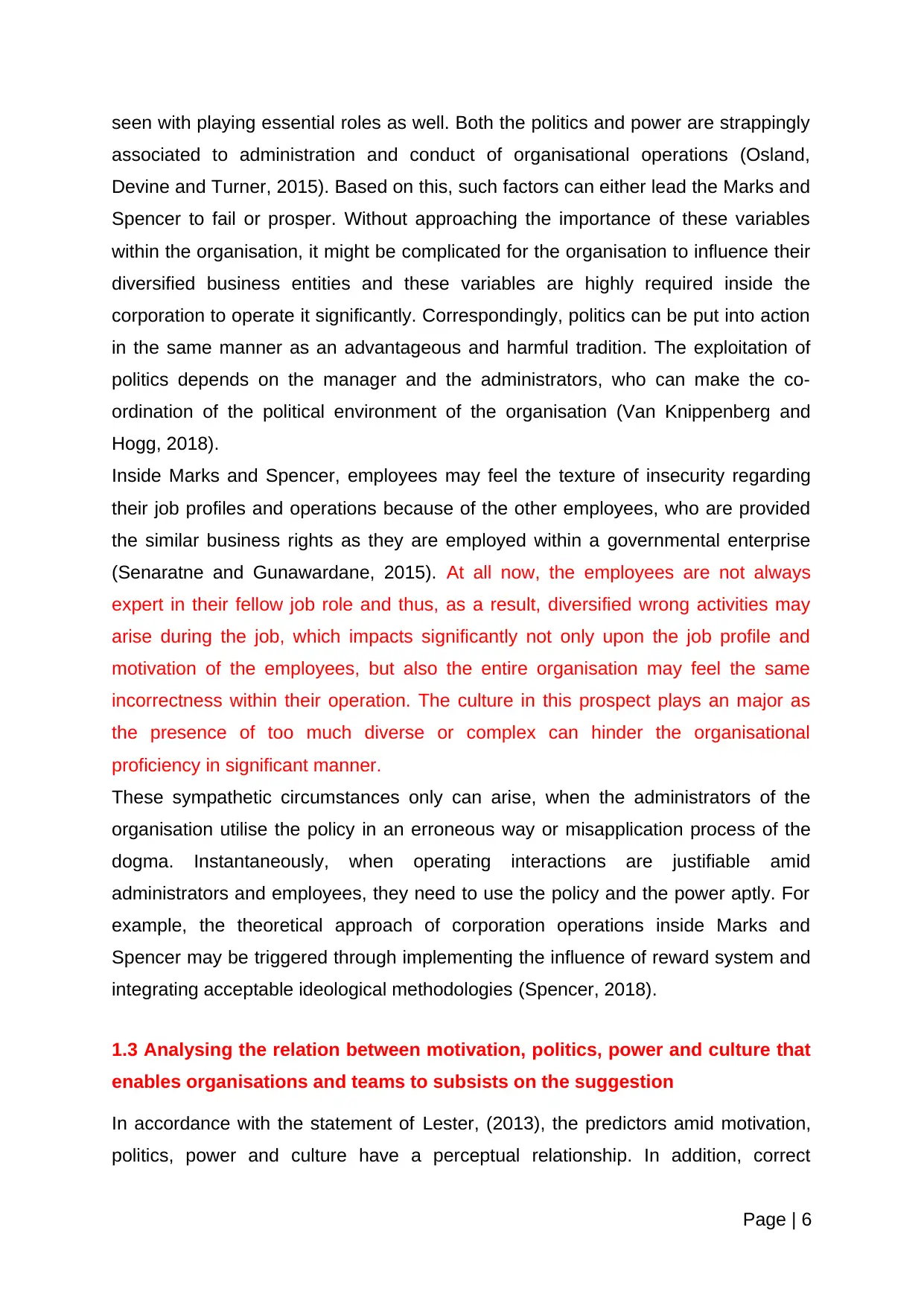
seen with playing essential roles as well. Both the politics and power are strappingly
associated to administration and conduct of organisational operations (Osland,
Devine and Turner, 2015). Based on this, such factors can either lead the Marks and
Spencer to fail or prosper. Without approaching the importance of these variables
within the organisation, it might be complicated for the organisation to influence their
diversified business entities and these variables are highly required inside the
corporation to operate it significantly. Correspondingly, politics can be put into action
in the same manner as an advantageous and harmful tradition. The exploitation of
politics depends on the manager and the administrators, who can make the co-
ordination of the political environment of the organisation (Van Knippenberg and
Hogg, 2018).
Inside Marks and Spencer, employees may feel the texture of insecurity regarding
their job profiles and operations because of the other employees, who are provided
the similar business rights as they are employed within a governmental enterprise
(Senaratne and Gunawardane, 2015). At all now, the employees are not always
expert in their fellow job role and thus, as a result, diversified wrong activities may
arise during the job, which impacts significantly not only upon the job profile and
motivation of the employees, but also the entire organisation may feel the same
incorrectness within their operation. The culture in this prospect plays an major as
the presence of too much diverse or complex can hinder the organisational
proficiency in significant manner.
These sympathetic circumstances only can arise, when the administrators of the
organisation utilise the policy in an erroneous way or misapplication process of the
dogma. Instantaneously, when operating interactions are justifiable amid
administrators and employees, they need to use the policy and the power aptly. For
example, the theoretical approach of corporation operations inside Marks and
Spencer may be triggered through implementing the influence of reward system and
integrating acceptable ideological methodologies (Spencer, 2018).
1.3 Analysing the relation between motivation, politics, power and culture that
enables organisations and teams to subsists on the suggestion
In accordance with the statement of Lester, (2013), the predictors amid motivation,
politics, power and culture have a perceptual relationship. In addition, correct
Page | 6
associated to administration and conduct of organisational operations (Osland,
Devine and Turner, 2015). Based on this, such factors can either lead the Marks and
Spencer to fail or prosper. Without approaching the importance of these variables
within the organisation, it might be complicated for the organisation to influence their
diversified business entities and these variables are highly required inside the
corporation to operate it significantly. Correspondingly, politics can be put into action
in the same manner as an advantageous and harmful tradition. The exploitation of
politics depends on the manager and the administrators, who can make the co-
ordination of the political environment of the organisation (Van Knippenberg and
Hogg, 2018).
Inside Marks and Spencer, employees may feel the texture of insecurity regarding
their job profiles and operations because of the other employees, who are provided
the similar business rights as they are employed within a governmental enterprise
(Senaratne and Gunawardane, 2015). At all now, the employees are not always
expert in their fellow job role and thus, as a result, diversified wrong activities may
arise during the job, which impacts significantly not only upon the job profile and
motivation of the employees, but also the entire organisation may feel the same
incorrectness within their operation. The culture in this prospect plays an major as
the presence of too much diverse or complex can hinder the organisational
proficiency in significant manner.
These sympathetic circumstances only can arise, when the administrators of the
organisation utilise the policy in an erroneous way or misapplication process of the
dogma. Instantaneously, when operating interactions are justifiable amid
administrators and employees, they need to use the policy and the power aptly. For
example, the theoretical approach of corporation operations inside Marks and
Spencer may be triggered through implementing the influence of reward system and
integrating acceptable ideological methodologies (Spencer, 2018).
1.3 Analysing the relation between motivation, politics, power and culture that
enables organisations and teams to subsists on the suggestion
In accordance with the statement of Lester, (2013), the predictors amid motivation,
politics, power and culture have a perceptual relationship. In addition, correct
Page | 6
⊘ This is a preview!⊘
Do you want full access?
Subscribe today to unlock all pages.

Trusted by 1+ million students worldwide
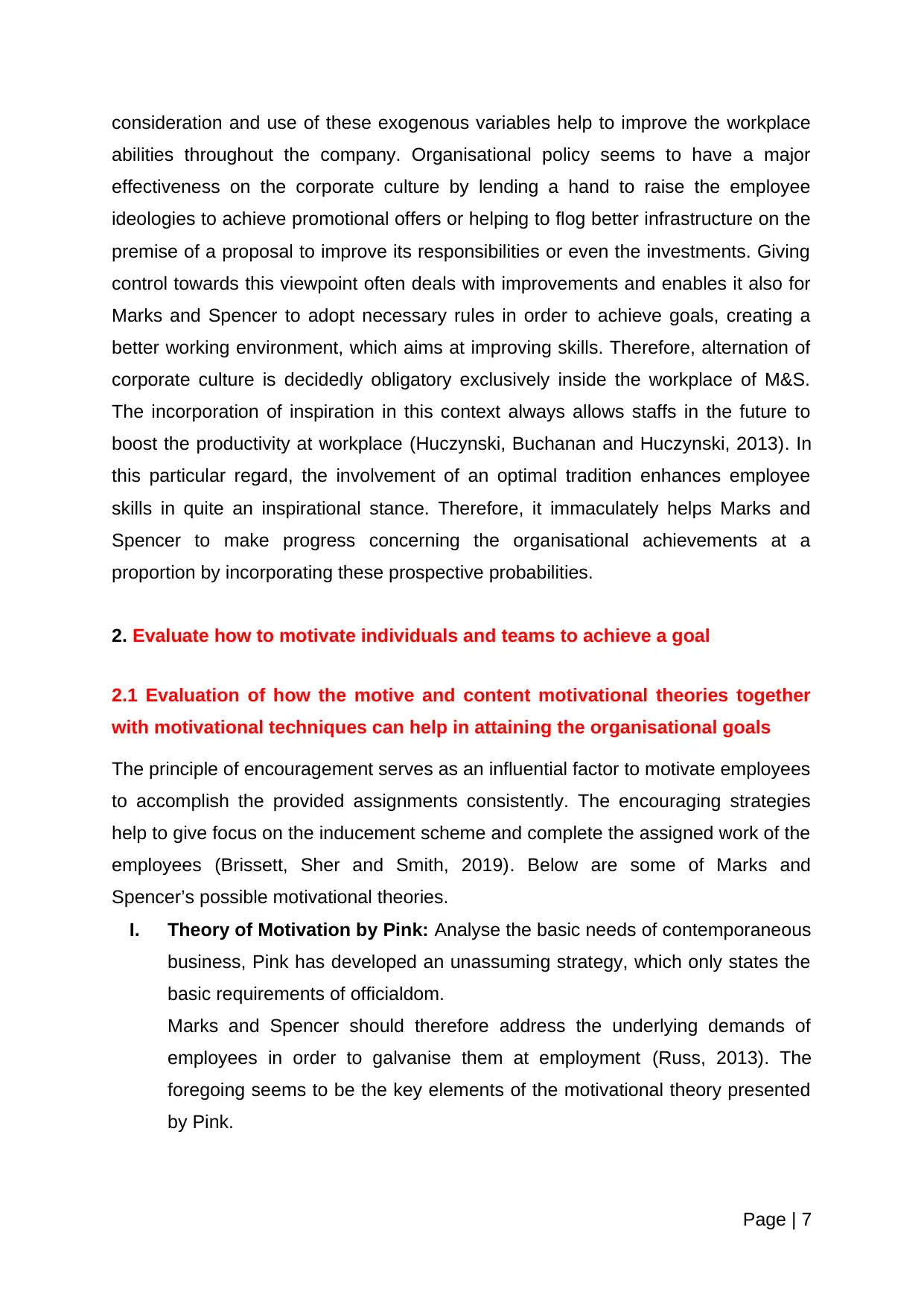
consideration and use of these exogenous variables help to improve the workplace
abilities throughout the company. Organisational policy seems to have a major
effectiveness on the corporate culture by lending a hand to raise the employee
ideologies to achieve promotional offers or helping to flog better infrastructure on the
premise of a proposal to improve its responsibilities or even the investments. Giving
control towards this viewpoint often deals with improvements and enables it also for
Marks and Spencer to adopt necessary rules in order to achieve goals, creating a
better working environment, which aims at improving skills. Therefore, alternation of
corporate culture is decidedly obligatory exclusively inside the workplace of M&S.
The incorporation of inspiration in this context always allows staffs in the future to
boost the productivity at workplace (Huczynski, Buchanan and Huczynski, 2013). In
this particular regard, the involvement of an optimal tradition enhances employee
skills in quite an inspirational stance. Therefore, it immaculately helps Marks and
Spencer to make progress concerning the organisational achievements at a
proportion by incorporating these prospective probabilities.
2. Evaluate how to motivate individuals and teams to achieve a goal
2.1 Evaluation of how the motive and content motivational theories together
with motivational techniques can help in attaining the organisational goals
The principle of encouragement serves as an influential factor to motivate employees
to accomplish the provided assignments consistently. The encouraging strategies
help to give focus on the inducement scheme and complete the assigned work of the
employees (Brissett, Sher and Smith, 2019). Below are some of Marks and
Spencer’s possible motivational theories.
I. Theory of Motivation by Pink: Analyse the basic needs of contemporaneous
business, Pink has developed an unassuming strategy, which only states the
basic requirements of officialdom.
Marks and Spencer should therefore address the underlying demands of
employees in order to galvanise them at employment (Russ, 2013). The
foregoing seems to be the key elements of the motivational theory presented
by Pink.
Page | 7
abilities throughout the company. Organisational policy seems to have a major
effectiveness on the corporate culture by lending a hand to raise the employee
ideologies to achieve promotional offers or helping to flog better infrastructure on the
premise of a proposal to improve its responsibilities or even the investments. Giving
control towards this viewpoint often deals with improvements and enables it also for
Marks and Spencer to adopt necessary rules in order to achieve goals, creating a
better working environment, which aims at improving skills. Therefore, alternation of
corporate culture is decidedly obligatory exclusively inside the workplace of M&S.
The incorporation of inspiration in this context always allows staffs in the future to
boost the productivity at workplace (Huczynski, Buchanan and Huczynski, 2013). In
this particular regard, the involvement of an optimal tradition enhances employee
skills in quite an inspirational stance. Therefore, it immaculately helps Marks and
Spencer to make progress concerning the organisational achievements at a
proportion by incorporating these prospective probabilities.
2. Evaluate how to motivate individuals and teams to achieve a goal
2.1 Evaluation of how the motive and content motivational theories together
with motivational techniques can help in attaining the organisational goals
The principle of encouragement serves as an influential factor to motivate employees
to accomplish the provided assignments consistently. The encouraging strategies
help to give focus on the inducement scheme and complete the assigned work of the
employees (Brissett, Sher and Smith, 2019). Below are some of Marks and
Spencer’s possible motivational theories.
I. Theory of Motivation by Pink: Analyse the basic needs of contemporaneous
business, Pink has developed an unassuming strategy, which only states the
basic requirements of officialdom.
Marks and Spencer should therefore address the underlying demands of
employees in order to galvanise them at employment (Russ, 2013). The
foregoing seems to be the key elements of the motivational theory presented
by Pink.
Page | 7
Paraphrase This Document
Need a fresh take? Get an instant paraphrase of this document with our AI Paraphraser

a) Autonomy: Pink claims that the ability to lead individual life needs to be
autonomous. Pink concluded that it goes against the conventional
administration perspective, where workers "conform" to what is demanded
from subordinates, to encourage workers’ independence (Leary, 2019). As an
example, it can be stated that if Marks and Spencer consent their employees
free time, it will motivate the employees to do their own things.
b) Purpose: Pink defines intent as the urge to do activities that are greater than
one. For instance, entrepreneurs are often encouraged by themselves to
“differentiate” but instead to maximize profits. In that case, for Marks and
Spencer, the managers should communicate to the employees regarding the
organisational goals and objectives in order to achieve the goal (Kearney,
2018). By optimising the approach, people within the workplace can be fitted
into the adequate role.
c) Mastery: Pink defines mastery as attempting to improve constantly on
something substantial. On the basis of that, people find the enjoyment as well
as satisfaction through their personal advancement and accomplishment. The
same thing matters for the people inside the workplace. Workers should have
the sagacity of progress towards the job role, which will subsidise to their
innermost drive (Lăzăroiu, 2015). Based on the “Goldilocks Tasks”
established by Pink himself, employees of every organisation including Marks
and Spencer should be offered diversified tasks those will be neither simple
nor exceedingly complex.
Figure: 3. Motivation Theory of Pink
(Source: Tutor2u, 2019)
Page | 8
autonomous. Pink concluded that it goes against the conventional
administration perspective, where workers "conform" to what is demanded
from subordinates, to encourage workers’ independence (Leary, 2019). As an
example, it can be stated that if Marks and Spencer consent their employees
free time, it will motivate the employees to do their own things.
b) Purpose: Pink defines intent as the urge to do activities that are greater than
one. For instance, entrepreneurs are often encouraged by themselves to
“differentiate” but instead to maximize profits. In that case, for Marks and
Spencer, the managers should communicate to the employees regarding the
organisational goals and objectives in order to achieve the goal (Kearney,
2018). By optimising the approach, people within the workplace can be fitted
into the adequate role.
c) Mastery: Pink defines mastery as attempting to improve constantly on
something substantial. On the basis of that, people find the enjoyment as well
as satisfaction through their personal advancement and accomplishment. The
same thing matters for the people inside the workplace. Workers should have
the sagacity of progress towards the job role, which will subsidise to their
innermost drive (Lăzăroiu, 2015). Based on the “Goldilocks Tasks”
established by Pink himself, employees of every organisation including Marks
and Spencer should be offered diversified tasks those will be neither simple
nor exceedingly complex.
Figure: 3. Motivation Theory of Pink
(Source: Tutor2u, 2019)
Page | 8

II. Motivation Theory of Herzberg: The motivation of theory of Herzberg is
termed by several names such as the “Two factor theory of motivation or
Hygiene theory. As per this theory the organisational behaviour is defined by
two variables such as motivational factors and hygiene factors. The lack of
hygiene factors cause dissatisfaction and the motivation factors drives the
motivation on the workers that fosters proficiency. Therefore, consideration of
motivational factors such as employee retention, remuneration and effective
leadership must be evaluated by Marks and Spencer. Simultaneously, the
organisation also has to maintain the credibility of hygiene factors such as
discipline, co-ordination, positive workplace environment and security to
sustain the motivation within the staffs.
Figure: 4. Herzberg’s Two Factor Theory of Motivation
(Source: Human Business, 2019)
The Assumption of Herzberg points out that people quite often attempt to comply
with the requirements of hygiene because discontentment boosts without those
hygiene factors. In order to increase workers’ effectiveness, M&S should consider
hygiene determinants into the workplace (Lăzăroiu, 2015). Four potentiality different
scenarios are entirely contingent on Herzberg’s hygienic or motivation theory as well
as the elements of motivation factor and hygiene factors are interconnected with
each other those are also needed to be monitored by Marks and Spencer.
Page | 9
termed by several names such as the “Two factor theory of motivation or
Hygiene theory. As per this theory the organisational behaviour is defined by
two variables such as motivational factors and hygiene factors. The lack of
hygiene factors cause dissatisfaction and the motivation factors drives the
motivation on the workers that fosters proficiency. Therefore, consideration of
motivational factors such as employee retention, remuneration and effective
leadership must be evaluated by Marks and Spencer. Simultaneously, the
organisation also has to maintain the credibility of hygiene factors such as
discipline, co-ordination, positive workplace environment and security to
sustain the motivation within the staffs.
Figure: 4. Herzberg’s Two Factor Theory of Motivation
(Source: Human Business, 2019)
The Assumption of Herzberg points out that people quite often attempt to comply
with the requirements of hygiene because discontentment boosts without those
hygiene factors. In order to increase workers’ effectiveness, M&S should consider
hygiene determinants into the workplace (Lăzăroiu, 2015). Four potentiality different
scenarios are entirely contingent on Herzberg’s hygienic or motivation theory as well
as the elements of motivation factor and hygiene factors are interconnected with
each other those are also needed to be monitored by Marks and Spencer.
Page | 9
⊘ This is a preview!⊘
Do you want full access?
Subscribe today to unlock all pages.

Trusted by 1+ million students worldwide
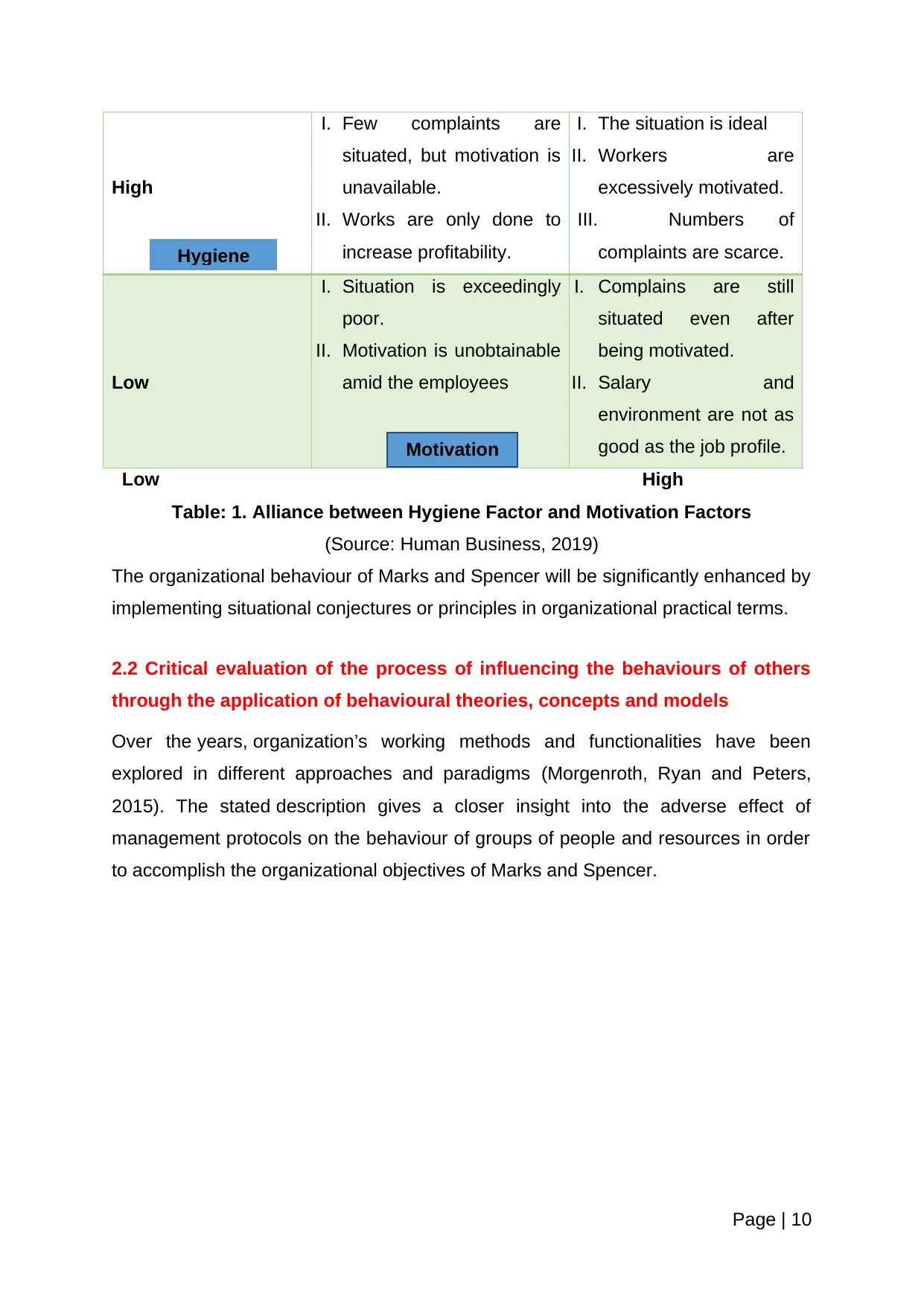
High
I. Few complaints are
situated, but motivation is
unavailable.
II. Works are only done to
increase profitability.
I. The situation is ideal
II. Workers are
excessively motivated.
III. Numbers of
complaints are scarce.
Low
I. Situation is exceedingly
poor.
II. Motivation is unobtainable
amid the employees
I. Complains are still
situated even after
being motivated.
II. Salary and
environment are not as
good as the job profile.
Low High
Table: 1. Alliance between Hygiene Factor and Motivation Factors
(Source: Human Business, 2019)
The organizational behaviour of Marks and Spencer will be significantly enhanced by
implementing situational conjectures or principles in organizational practical terms.
2.2 Critical evaluation of the process of influencing the behaviours of others
through the application of behavioural theories, concepts and models
Over the years, organization’s working methods and functionalities have been
explored in different approaches and paradigms (Morgenroth, Ryan and Peters,
2015). The stated description gives a closer insight into the adverse effect of
management protocols on the behaviour of groups of people and resources in order
to accomplish the organizational objectives of Marks and Spencer.
Page | 10
Hygiene
Motivation
I. Few complaints are
situated, but motivation is
unavailable.
II. Works are only done to
increase profitability.
I. The situation is ideal
II. Workers are
excessively motivated.
III. Numbers of
complaints are scarce.
Low
I. Situation is exceedingly
poor.
II. Motivation is unobtainable
amid the employees
I. Complains are still
situated even after
being motivated.
II. Salary and
environment are not as
good as the job profile.
Low High
Table: 1. Alliance between Hygiene Factor and Motivation Factors
(Source: Human Business, 2019)
The organizational behaviour of Marks and Spencer will be significantly enhanced by
implementing situational conjectures or principles in organizational practical terms.
2.2 Critical evaluation of the process of influencing the behaviours of others
through the application of behavioural theories, concepts and models
Over the years, organization’s working methods and functionalities have been
explored in different approaches and paradigms (Morgenroth, Ryan and Peters,
2015). The stated description gives a closer insight into the adverse effect of
management protocols on the behaviour of groups of people and resources in order
to accomplish the organizational objectives of Marks and Spencer.
Page | 10
Hygiene
Motivation
Paraphrase This Document
Need a fresh take? Get an instant paraphrase of this document with our AI Paraphraser
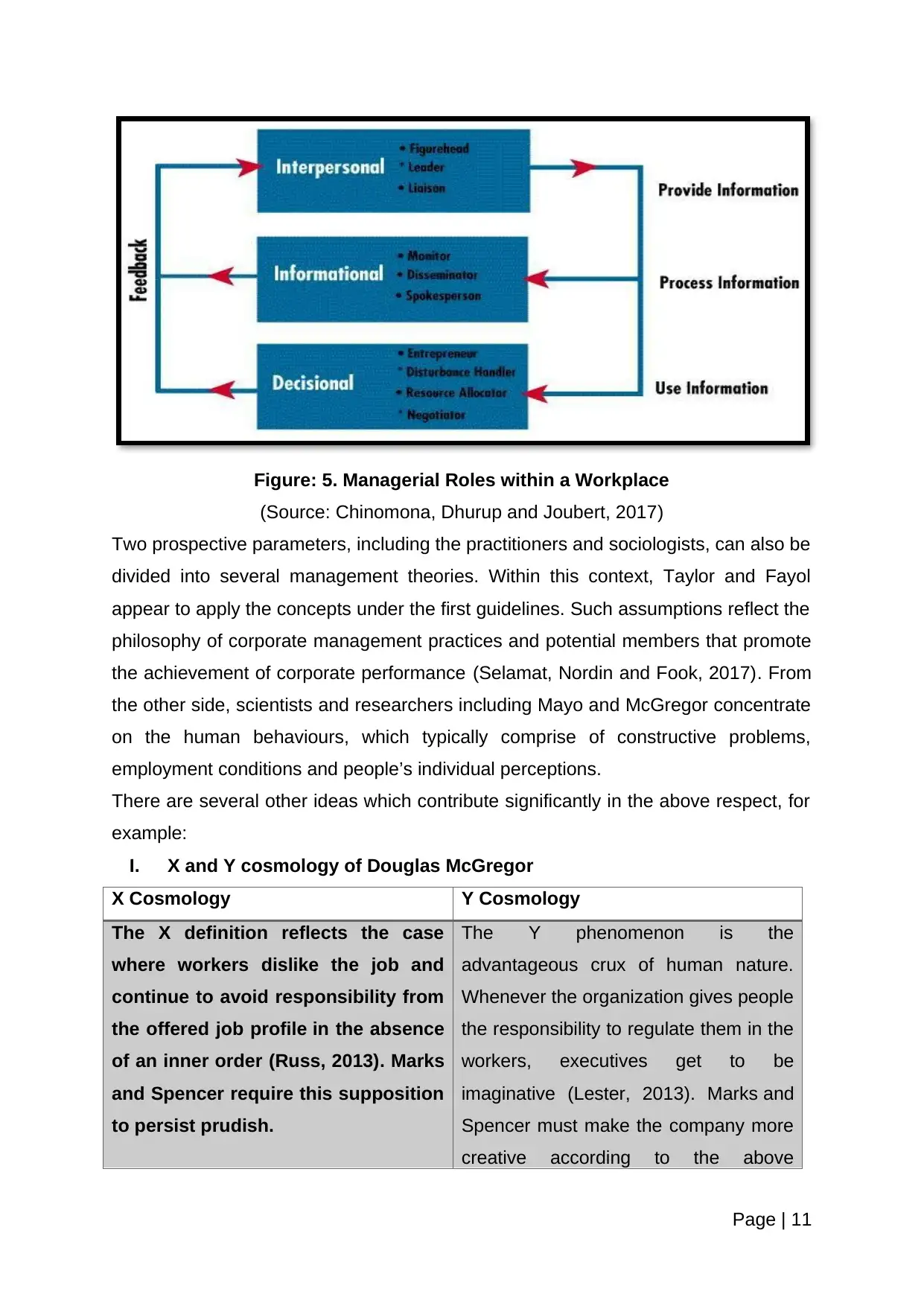
Figure: 5. Managerial Roles within a Workplace
(Source: Chinomona, Dhurup and Joubert, 2017)
Two prospective parameters, including the practitioners and sociologists, can also be
divided into several management theories. Within this context, Taylor and Fayol
appear to apply the concepts under the first guidelines. Such assumptions reflect the
philosophy of corporate management practices and potential members that promote
the achievement of corporate performance (Selamat, Nordin and Fook, 2017). From
the other side, scientists and researchers including Mayo and McGregor concentrate
on the human behaviours, which typically comprise of constructive problems,
employment conditions and people’s individual perceptions.
There are several other ideas which contribute significantly in the above respect, for
example:
I. X and Y cosmology of Douglas McGregor
X Cosmology Y Cosmology
The X definition reflects the case
where workers dislike the job and
continue to avoid responsibility from
the offered job profile in the absence
of an inner order (Russ, 2013). Marks
and Spencer require this supposition
to persist prudish.
The Y phenomenon is the
advantageous crux of human nature.
Whenever the organization gives people
the responsibility to regulate them in the
workers, executives get to be
imaginative (Lester, 2013). Marks and
Spencer must make the company more
creative according to the above
Page | 11
(Source: Chinomona, Dhurup and Joubert, 2017)
Two prospective parameters, including the practitioners and sociologists, can also be
divided into several management theories. Within this context, Taylor and Fayol
appear to apply the concepts under the first guidelines. Such assumptions reflect the
philosophy of corporate management practices and potential members that promote
the achievement of corporate performance (Selamat, Nordin and Fook, 2017). From
the other side, scientists and researchers including Mayo and McGregor concentrate
on the human behaviours, which typically comprise of constructive problems,
employment conditions and people’s individual perceptions.
There are several other ideas which contribute significantly in the above respect, for
example:
I. X and Y cosmology of Douglas McGregor
X Cosmology Y Cosmology
The X definition reflects the case
where workers dislike the job and
continue to avoid responsibility from
the offered job profile in the absence
of an inner order (Russ, 2013). Marks
and Spencer require this supposition
to persist prudish.
The Y phenomenon is the
advantageous crux of human nature.
Whenever the organization gives people
the responsibility to regulate them in the
workers, executives get to be
imaginative (Lester, 2013). Marks and
Spencer must make the company more
creative according to the above
Page | 11
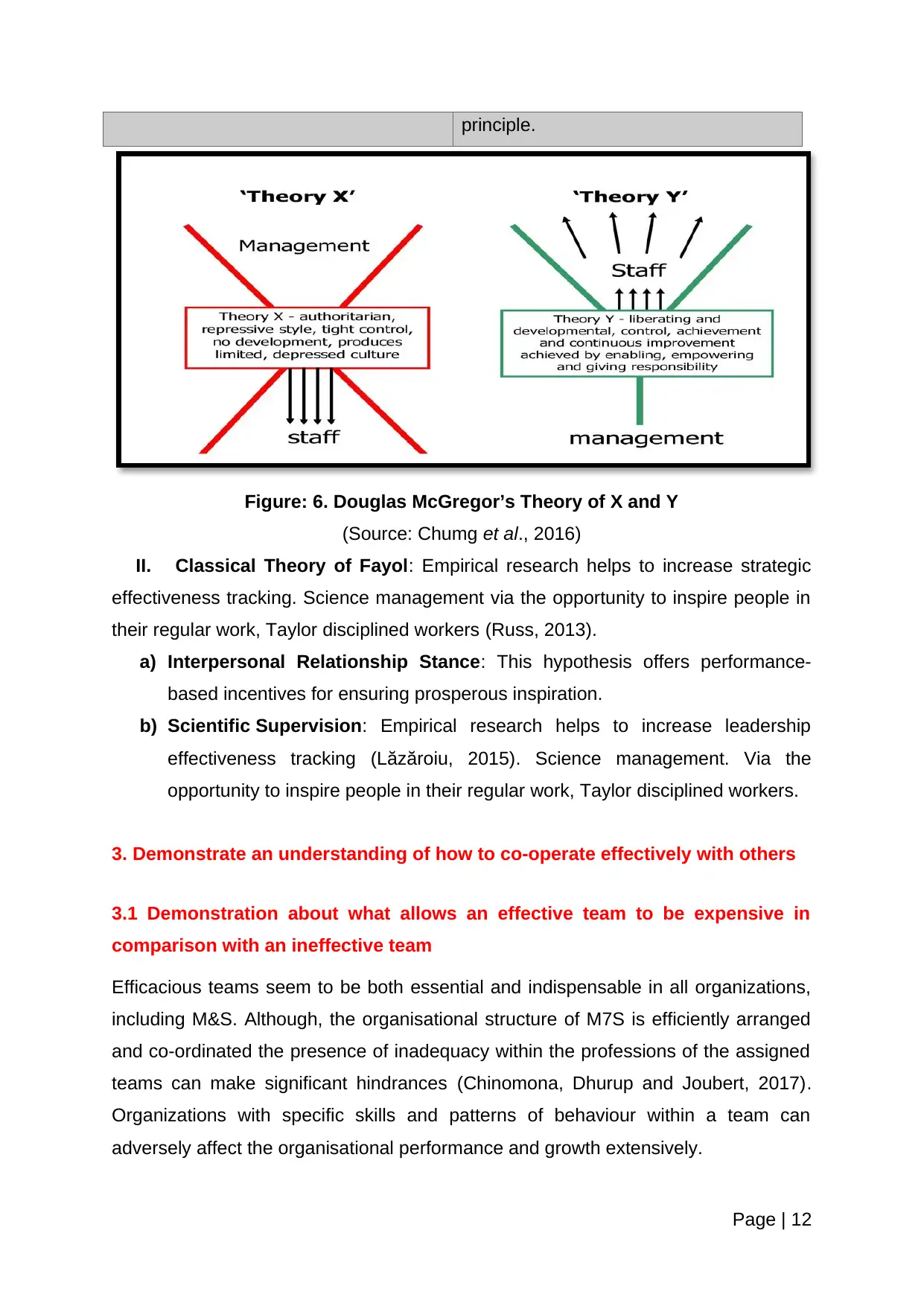
principle.
Figure: 6. Douglas McGregor’s Theory of X and Y
(Source: Chumg et al., 2016)
II. Classical Theory of Fayol: Empirical research helps to increase strategic
effectiveness tracking. Science management via the opportunity to inspire people in
their regular work, Taylor disciplined workers (Russ, 2013).
a) Interpersonal Relationship Stance: This hypothesis offers performance-
based incentives for ensuring prosperous inspiration.
b) Scientific Supervision: Empirical research helps to increase leadership
effectiveness tracking (Lăzăroiu, 2015). Science management. Via the
opportunity to inspire people in their regular work, Taylor disciplined workers.
3. Demonstrate an understanding of how to co-operate effectively with others
3.1 Demonstration about what allows an effective team to be expensive in
comparison with an ineffective team
Efficacious teams seem to be both essential and indispensable in all organizations,
including M&S. Although, the organisational structure of M7S is efficiently arranged
and co-ordinated the presence of inadequacy within the professions of the assigned
teams can make significant hindrances (Chinomona, Dhurup and Joubert, 2017).
Organizations with specific skills and patterns of behaviour within a team can
adversely affect the organisational performance and growth extensively.
Page | 12
Figure: 6. Douglas McGregor’s Theory of X and Y
(Source: Chumg et al., 2016)
II. Classical Theory of Fayol: Empirical research helps to increase strategic
effectiveness tracking. Science management via the opportunity to inspire people in
their regular work, Taylor disciplined workers (Russ, 2013).
a) Interpersonal Relationship Stance: This hypothesis offers performance-
based incentives for ensuring prosperous inspiration.
b) Scientific Supervision: Empirical research helps to increase leadership
effectiveness tracking (Lăzăroiu, 2015). Science management. Via the
opportunity to inspire people in their regular work, Taylor disciplined workers.
3. Demonstrate an understanding of how to co-operate effectively with others
3.1 Demonstration about what allows an effective team to be expensive in
comparison with an ineffective team
Efficacious teams seem to be both essential and indispensable in all organizations,
including M&S. Although, the organisational structure of M7S is efficiently arranged
and co-ordinated the presence of inadequacy within the professions of the assigned
teams can make significant hindrances (Chinomona, Dhurup and Joubert, 2017).
Organizations with specific skills and patterns of behaviour within a team can
adversely affect the organisational performance and growth extensively.
Page | 12
⊘ This is a preview!⊘
Do you want full access?
Subscribe today to unlock all pages.

Trusted by 1+ million students worldwide
1 out of 22
Related Documents
Your All-in-One AI-Powered Toolkit for Academic Success.
+13062052269
info@desklib.com
Available 24*7 on WhatsApp / Email
![[object Object]](/_next/static/media/star-bottom.7253800d.svg)
Unlock your academic potential
Copyright © 2020–2025 A2Z Services. All Rights Reserved. Developed and managed by ZUCOL.

